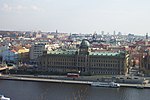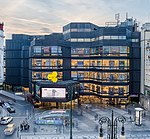La Degustation
Czech restaurantsRestaurants in Prague

La Degustation Bohême Bourgeoise is an upscale restaurant that offers traditional Czech cuisine on Haštalská Street in Prague. Forbes Life called it the "first choice for its buckle-in, three-hour seven-course tasting menus (plus a blizzard of Amuse-bouches)." In 2009, it was selected the best restaurant in the Czech Republic, and received the Grand Restaurant 2010 award, presented annually by the Czech Association of Restaurateurs. The restaurant offers three menus: Czech traditional, Czech inspired fusion, and pan-European, that can be mixed. It has been awarded with Michelin star since 2012.
Excerpt from the Wikipedia article La Degustation (License: CC BY-SA 3.0, Authors, Images).La Degustation
Haštalská, Prague Old Town
Geographical coordinates (GPS) Address Nearby Places Show on map
Geographical coordinates (GPS)
| Latitude | Longitude |
|---|---|
| N 50.090988888889 ° | E 14.425116666667 ° |
Address
Haštalská 753/18
110 00 Prague, Old Town
Prague, Czechia
Open on Google Maps











